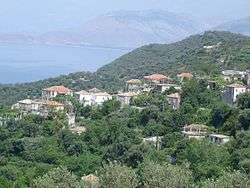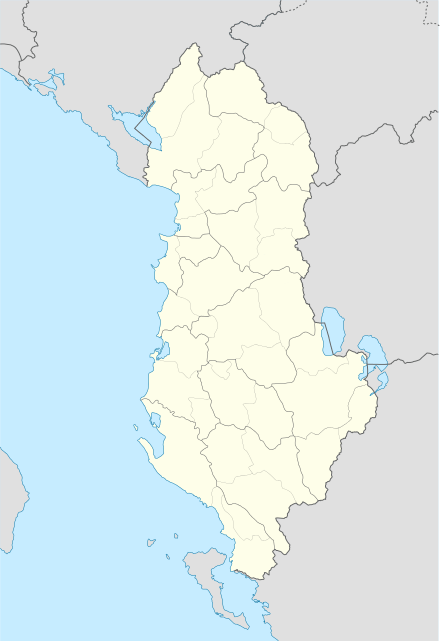Lukovë
Lukovë (definite Albanian form: Lukova) is a village and a former municipality in the Vlorë County, southern Albania. At the 2015 local government reform it became a subdivision of the municipality Himarë.[1] The population at the 2011 census was 2,916.[2]
Lukovë | |
|---|---|
 Lukova village | |
 Lukovë | |
| Coordinates: 39°59′N 19°55′E | |
| Country | |
| County | Vlorë |
| Municipality | Himarë |
| Population (2011) | |
| • Municipal unit | 2,916 |
| Time zone | UTC+1 (CET) |
| • Summer (DST) | UTC+2 (CEST) |
| Vehicle registration | SR |
Name
The Albanian toponym Lukovë stems from Slavic from either the words Luk, Laka, Luka meaning water flowing nearby, meadowland, river meadow, wet meadow along a river or from luk, luka, place of onions; alongside the suffix ov/a.[3] The village is known in Greek as "Λούκοβο".
History
During the Ottoman period Lukovë together with nearby Piqeras and Nivicë was part of the Himara area and enjoyed special semi-autonomous status inside this community.[4] In 1570-1571 a short lived rebellion broke out under Emmanuel Mormoris in Himara region. After a prolonged siege the rebels managed to capture the castle of Nivicë.[5]
In 1798 Lukovë together with adjacent villages in the region south of Himara were attacked and plundered by the local Ottoman lord Ali Pasha of Ioannina.[6] In the villages of Nivice and Shën Vasil massacres of Orthodox inhabitants were committed in Easter of 1798. As such cases of massive islamization among the local population were followed in the region.[7]
During the end of the 19th century Greek elementary schools were already operating in the villages of Lukovë, Nivicë, Çorraj and Shën Vasil.[8]
Demographics
According to German academic research conducted in 1957 the villages of Piqeras, Lukovë and Sasaj were among the Greek speaking pockets on the Albanian Ionian coast.[9]
The municipal unit consists of the following settlements:[10] According to 1991 estimates, Lukovë, the municipal seat is inhabited by a majority Orthodox Albanian population (2076 or 82%) alongside minorities of Muslim Albanians (250 or 12%) and Greeks (150 or 6%).[11] Borsh, Fterrë and Sasaj are exclusively populated by Muslim Albanians.[11] Piqeras is inhabited by an Orthodox Albanian majority (991) with a minority of 100 Muslim Albanians and 50 Greeks.[11] Çorraj is a mixed village inhabited by an Orthodox Albanian population and Albanian Muslims.[11] Shën Vasil (Shënvasi) is inhabited by a majority Orthodox Albanian population (1434) and with a minority of Muslim Albanians (220) and Greeks (210).[11] Nivicë is inhabited by an Orthodox Albanian majority (899) and a minority of Greeks (30).[11] Qazim Pali is a new village established during the communist period and is populated by Muslim Albanians (861) alongside minorities of Orthodox Albanians (50) and Greeks (80).[11] In a demographic investigation by Leonidas Kallivretakis in the late 20th century, the population of Lukovë commune and all its villages, 54% were Albanian Christians, 40% were Albanian Muslims and 6% were Greek Christians.[11]
Seaside settlements of the Lukovë area were among Greek minority areas that underwent a substantial decrease in population after the restoration of democracy in Albania in the early 1990s.[12]
Notable people
- Nafiz Bezhani, jurist, politician and writer.
- Dimitrios Doulis (1865–1928), minister of military affairs of the Autonomous Republic of Northern Epirus, from Nivice.
- Muzafer Korkuti, archaeologist and Vice President of the Academy of Sciences of Albania
- Vasil Laçi (1922–1941), Albanian patriot who attempted to kill in 1941 Victor Emmanuel III, then King of Italy and Shefqet Bej Vërlaci, then Prime Minister of Albania
- Jakup Mato, head of Centre of Art Studies of the Academy of Sciences of Albania.
- Niphon Kausokalybites (1316–1411), monk and saint of the Eastern Orthodox Church
References
- "Law nr. 115/2014" (PDF). Archived from the original (PDF) on 2015-09-24. Retrieved 2015-06-16.
- 2011 census results Archived 2016-03-04 at the Wayback Machine
- Ylli, Xhelal (2000). Das slavische Lehngut im Albanischen. 2 [Slavic settlement in Albania. Verlag Otto Sagner. p. 139. "LUKÓV/È, -A ( 1431 Lokove, Sopot; BZHS III :1759,1856 Aouxoßov, Delvinë); + LUKOVE (1431, Korçë) A. SE 228 Луково; JO 624.B. SE erklärt den DN als Benennung eines Dorfes nach dem in der Nähe fließenden Gewässer: adj. Bildung zu aksl. лжка ,Biegung; Sumpf, bulg. лъка ,Wiesenland; Flußwiese‘, так. mundartl. лака ,feuchte Wiese längs eines Flusses4, serb. лука ,Meerbusen; Wiese; Tal4, БЕРЗ 551,+ -ов-а. Die älteren Formen haben in der ersten Silbe о / и. Es ist schwer zu entscheiden, welche Form zutriflft. Ein Reflex aksl. ж > и kommt nicht im Bulg. vor, aber ihn findet man im Mak. mundartl. und im Serb. Andererseits findet auch eine Entwicklung о > и innerhalb der historischen Phonologie des Albanischen keine Stütze. Mit einem Einfluß des Serbischen, besonders fur Korça, ist ebenfalls nicht zu rechnen. Man könnte den ON aus zwei verschiedenen Wurzeln herieiten: im Falle von SR aus serb. лука ,Au, Meerbusen, Wiese, Tal4, wobei mit dem Einfluß der serb. Königreiche zu rechnen ist, und im Falle von Korça, ein bekanntes Gebiet für die Herstellung von Zwiebeln, aus der Wurzel bulg, лука ,Zwiebel‘."
- From the Turkish Conquest to the Beginning of the Nineteenth Century: Terms of Submission - The "Privileges" (in "4000 years of Greek history and civilization" Vranousis L., Sfyroeras B., Ekdotike Athenon, 1997. ISBN 978-960-213-371-2, p. 243.
- Konstantinos., Giakoumis (2002). "The monasteries of Jorgucat and Vanishte in Dropull and of Spelaio in Lunxheri as monuments and institutions during the Ottoman period in Albania (16th-19th centuries)": 21. Retrieved 8 July 2018. Cite journal requires
|journal=(help) - Pappas, Nicholas Charles (1982). Greeks in Russian military service in the late eighteen and early nineteenth centuries. Stanford University. p. 265.
Following this, Ali's troops attacked and pillaged other habitations in southern Cheimarra, such as Loukovo, Lykouresi, Agios Vasileios, Pikerni and Borsi. The rest of the area held off the assault. Those Cheimarriotes in the south who were not killed or found refuge in the remaining free area of their community were sent to the çiftliks of Ali Pasha in the Trikalla region of Thessaly as tenant farmers .
- Skendi, Stavro (1980). Balkan Cultural Studies. East European Monographs. p. 159. ISBN 978-0-914710-66-0.
Following the massacre in the church on Easter day 1798 of the Orthodox Christians of Shën Vasil and Nivica - Bubari
- Vakalopoulos, Kōnstantinos Apostolou (2003). History of Epirus: From Ottoman Times to Present (in Greek). Hērodotos. p. 620.
στο Τσοράϊ , στο Λούκοβο , στη Νέβιτσα και στον Άγ . Βασίλειο λειτουργούσαν δημοτικά σχολεία . Ο Βούνος , το Πικέρνι και το Κηπαρό συντηρούσαν από 1 δημοτικό , 1 ελληνικό σχολείο και 1 παρθεναγωγείο.
- Fiedler, Wilfried (2006). "Einführung in die Albanologie" (PDF). albanologie.uni-muenchen.de. p. 5. Retrieved 4 August 2020.
- Greece – Albania Neighbourhood Programme Archived 2012-03-27 at the Wayback Machine
- Kallivretakis, Leonidas (1995). "Η ελληνική κοινότητα της Αλβανίας υπό το πρίσμα της ιστορικής γεωγραφίας και δημογραφίας [The Greek Community of Albania in terms of historical geography and demography." In Nikolakopoulos, Ilias, Kouloubis Theodoros A. & Thanos M. Veremis (eds). Ο Ελληνισμός της Αλβανίας [The Greeks of Albania]. University of Athens. p. 51. "Ε Έλληνες, ΑΧ Αλβανοί Ορθόδοξοι Χριστιανοί, AM Αλβανοί Μουσουλμάνοι, ΤΣ Τσάμηδες, Β Βλάχοι, Μ Μικτός πληθυσμός”; p.53. "LUKOVE ΛΟYKΟBΟ 2076 ΑΧ + αμ (250) + ε (120); NIVICE ΝΙΒΓΓΣΑ 899 ΑΧ + ε (30); SHENVASIL Αϊ ΒΑΣΙΛΗ 1434 ΑΧ + αμ (220) + ε (210); PIQERAS ΠΙΚΙΕΡΑΣ (ΠΙΚΕΡΝΗ) 991 ΑΧ + αμ (100) + ε (50); SASAJ ΣΑΣΑΪ 297 AM; BORSH ΜΠΟΡΣΙ 1243 AM; FTERE ΦΤΕΡΑ 378 AM; ÇORAJ ΤΣΟΡΑΪ 282 ΑΧ (150) + AM (132); QAZIM PALI ΚΙΑΣΙΜ ΠΑΛΙ (νέο) 861 AM + ε (80) + αχ (50)"
- Pettifer, James; Poulton, Hugh (1994). The Southern Balkans. Minority Rights Group. ISBN 978-1-897693-75-9.
As a result there has been a substantial depopulation of many Greek minority areas in southern Albania in the last two years, particularly in the coastal villages around Lukova and Himara
External links
| Wikimedia Commons has media related to Lukova. |
| Wikivoyage has a travel guide for Lukove. |

